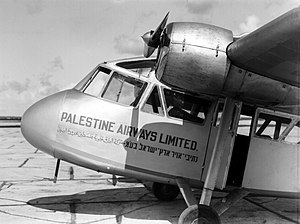Economy of Mandatory Palestine refers to the economy and financial development of the British Mandatory Palestine between 1920 and 1948.
Between 1922 and 1947, the annual growth rate of the Jewish sector of the economy was 13.2%, mainly due to immigration and foreign capital, while that of the Arab was 6.5%. Per capita, these figures were 4.8% and 3.6% respectively. By 1936, the Jewish sector earned 2.6 times as much as Arabs. Compared to Arab countries, the Palestinian Arab individuals earned slightly more.
The country's largest industrial zone was in Haifa, where many housing projects were built for employees. Haifa was the location of the Haifa oil refinery, established in the 1930s, and the end point of the Kirkuk-Haifa oil pipeline, transporting oil from the Kingdom of Iraq.
The Jaffa Electric Company was founded in 1923 by Pinhas Rutenberg, and was later absorbed into a newly created Palestine Electric Company. Palestine Airways was founded in 1934, Angel Bakeries in 1927, and the Tnuva dairy in 1926. Electric current mainly flowed to Jewish industry, following it to its nestled locations in Tel Aviv and Haifa. Although Tel Aviv had by far more workshops and factories, the demand for electric power for industry was roughly the same for both cities by the early 1930s.
Economic growth
Between 1922 and 1947, the annual growth rate of the Jewish sector of the economy was 13.2%, mainly due to immigration and foreign capital, while that of the Arab was 6.5%. Per capita, these figures were 4.8% and 3.6% respectively. By 1936, the Jewish sector earned 2.6 times as much as Arabs. Compared to Arab countries, the Palestinian Arab individuals earned slightly more.
On the scale of the UN Human Development Index determined for around 1939, of 36 countries, Palestinian Jews were placed 15th, Palestinian Arabs 30th, Egypt 33rd and Turkey 35th. The Jews in Palestine were mainly urban, 76.2% in 1942, while the Arabs were mainly rural, 68.3% in 1942. Overall, Khalidi concludes that Palestinian Arab society, while overmatched by the Yishuv, was as advanced as any other Arab society in the region and considerably more than several.
Energy
Oil
Main articles: Kirkuk–Haifa oil pipeline and Haifa oil refineryThe country's largest industrial zone was in Haifa, where many housing projects were built for employees. Haifa was the location of the Haifa oil refinery, established in the 1930s, and the end point of the Kirkuk-Haifa oil pipeline, transporting oil from the Kingdom of Iraq.
Electricity
Main article: Israel Electric CorporationThe Jaffa Electric Company was founded in 1923 by Pinhas Rutenberg, and was later absorbed into a newly created Palestine Electric Company. Electric current mainly flowed to Jewish industry, following it to its nestled locations in Tel Aviv and Haifa. Although Tel Aviv had by far more workshops and factories, the demand for electric power for industry was roughly the same for both cities by the early 1930s.
Transport
Air transport
Main article: Palestine Airways
Palestine Airways (also: Palestine Air Transport) was an airline founded by Zionist Pinhas Rutenberg in British Palestine, in conjunction with the Histadrut and the Jewish Agency. In 1937 the airline was taken over by British Government's Air Ministry, with the intention of it eventually being transferred back into private hands.
It operated from July 1937 until August 1940, under the aegis of the British corporation Imperial Airways.
Shipping
Until the beginning of the 20th century, Acre served as the main port for the region. However, the port eventually became clogged with silt, and was unable to accommodate large ships. The first person to comprehend the tremendous possibilities of a port in Haifa was Theodor Herzl, the father of Political Zionism, who in 1902 wrote a prophetic description of the town in his book AltNeuland. Construction of the port began in 1922, and it was officially opened on October 31, 1933 by Lieut. Gen. Sir Arthur Wauchope, the British High Commissioner for Palestine. The port allowed Haifa to blossom, and in 1936, the city had over 100,000 inhabitants. The port was a gateway for thousands of immigrants after the Second World War. The port had been the scene of the Patria disaster in 1940, which killed 267 people.
See also
References
- (Khalidi 2006, pp. 13–14)
- (Khalidi 2006, p. 27)
- Noam Dvir (5 April 2012). "Haifa's glass house transparent, but still an Israeli mystery". Haaretz.
- Shamir, Ronen (2013). Current Flow: The Electrification of Palestine. Stanford: Stanford University Press.
- (Khalidi 2006, pp. 13–14)
- (Khalidi 2006, p. 27)
- (Khalidi 2006, p. 16)
- (Khalidi 2006, p. 17)
- (Khalidi 2006, pp. 29–30)
- Noam Dvir (5 April 2012). "Haifa's glass house transparent, but still an Israeli mystery". Haaretz.
- Shamir, Ronen (2013). Current Flow: The Electrification of Palestine. Stanford: Stanford University Press.
- Dagan, Peretz (1955). Pillars of Israel Economy. I. Lipschitz. p. 306.
- Davies, Ronald Edward George (1964). A History of the World's Airlines. Oxford University Press. p. 200.
- "Jewish Airline". Israel Air Force. Retrieved 19 November 2014.
- "Palestine Airways Expects to Resume Service Shortly Throughout Middle East". 20 March 2015.
- Edelheit, Hershel (2000). History of Zionism. Westview Press. p. 571. ISBN 0813329817.
- "Israel : The American Institute of Aeronautics and Astronautics". Archived from the original on 2017-08-29. Retrieved 2019-08-02.
- "Troops on Guard as Britain Opens Harbor of Haifa". Chicago Daily Tribune. 1933-11-01. p. 24. Archived from the original on 2007-10-01. Retrieved 2007-08-24.
- Samuels, Gertrude (1949-08-21). "From Munich to Haifa: Journey Into the Light; For present-day Israeli immigrants, the trip is a dawn of hope after many years of dark tragedy". The New York Times. Retrieved 2007-08-24.
Bibliography
- Khalidi, Rashid (2006). The Iron Cage: The Story of the Palestinian Struggle for Statehood. Beacon Press. ISBN 978-0-8070-0308-4. Retrieved 2 May 2009.